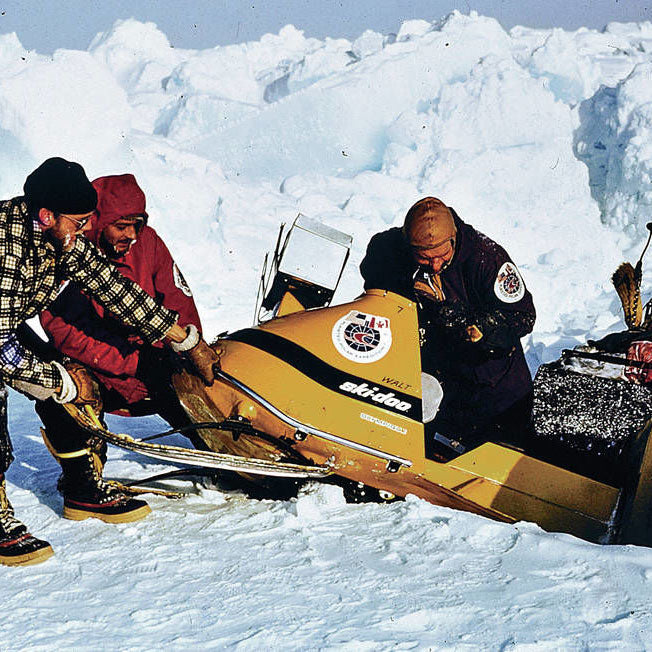
I was reminded again of this event from a conversation I had last night. As I reminisced over coffee this morning, I figured it'd be worth sharing before the details are forgotten…
I remember the coffee that morning was similar to the taste of the one I am drinking now. But the weather was quite different. In the wheelhouse that morning, I debated making the crossing through the drift ice of Hinlopen Strait of northern Svalbard. Hinlopen Strait has had a reputation of keeping arctic fishermen awake at night, as the ice flows coming from either the north or the south end of the strait can suddenly fill up and clog the straight, leaving no way out for the trapped and vulnerable wooden fishing boats of that time. Having navigated through ice flows before, I felt that the fog would be a nice morning challenge. And besides, the vessel Arctica II was 5mm thick steel! The odds were on my side! With the radar acting as my eyes to help me see the scattered ice ahead and keeping a keen eye ahead of the bow at an easy pace of 4 to 5 knots, I figured we could take our chances and enjoy the adventure.
It went better than I had expected! At least initially. The fog was interesting that day as it wasn't continuous. There'd be pockets of clear air allowing me to see sometimes hundreds of meters ahead, while other times it'd be so thick, I had to put the engine in neutral and drift as I could only see a few meters ahead of the bow.
After some time, like the sea ice my restless mind started to drift to other tasks again. There's always something to fix on a boat and a pocket of clear air opened up through the fog. In my mind, I saw this as a perfect opportunity to fix the screen on one of the chart plotters. I could still work at the helm but ALSO be able to get the screen on the port side plotter to display again. This was the ultimate mistake. I lacked respect for the arctic for a brief moment and paid for it! Looking back on it now, I still have a hard time thinking about how naive that was. To start to fiddle with some minute task in fog, through an ice flow! The patches of fog had deceived me. Although, I was still at the helm and we were moving slowly; being distracted by the port side plotter for a meer 2 minutes was all that was needed. Chico, who was helping me at the helm while I worked on the plotter slapped me on the shoulder. "ICE, ICE!!"
Shit.
It was still a few meters away, maybe there is still a chance to prevent this! I reached for the throttle and pulled it back. The boat, weighing over 40 tons, didn't slow and putting the engine in reverse would have stalled the engine as we were going over 3 knots. It was too damn late.
Luckily, the ice was a sheet rather than the brittle blue glacial ice which certainly would have enough weight and strength to tear off the pulpit. But the sheet gave the ice the advantage of being harder to detect as it was invisible to radar and could only be seen as a thin white line on the surface of the water.
The bow of the vessel rode up on top of the ice sheet and came to a slamming halt as the keel hit the edge of the ice sheet flinging all of us forward.
And there we were, with a 40 ton steel cutter sitting on top of an ice sheet around 80 degrees north drifting in the fog of the Hinlopet straight with its icy jaws slowly closing in on us.
Putting those thoughts aside, I tried to focus myself on the task at hand. Luckily, the propellor was still in the water, and this made it possible to pull the boat off of the ice sheet. Thank goodness! The boat is free and back in the water!
But then I heard the sound that no skipper wants to hear. The sound of the icy dark arctic water gushing in. The autobilge had already started and was roaring. Just to be safe and sure, I turned on the engine room bilge as well to keep the water level at bay.
But where was it coming from? I could hear it and see the bilge being pumped like crazy. I quickly jumped in the dinghy to inspect the hull. Any cracks? Hmmm no cracks, maybe it's deeper than I can see?
I returned to the boat and listened to her again. The sound was coming from the bow. Frantically ripping out the floorboards I was met with a spray to the face of cold seawater. Found it!
My spirits were lifted! No horrible god-awful cracks! Instead, it was a perfect circle. When the boat was resting on the ice, the weight of the vessel popped the sonar sensor out of place allowing the water to easily come in.
This should be an easy fix! Over the SAT phone, I call home base to ask where the wooden plugs might be. Heinrich told me to check under the helm seat. There were plugs but, unfortunately, none of the plugs were big enough. Heinrich then chirps, "No problem! You are almost to Nordaustlandet! There should be plenty of driftwood on shore for you to work with there!"
We plug the hole with some towels and duct tape. Chico put is weight on the hole as well. Still leaking but at least now, it was a manageable flow.
Doing as Heinrich recommends, I drop anchor, grab the old orange survival suit, the Mauser rifle along with a handful of bullets, a flare gun, the VHF radio and head to the shores of Nordaustlandet.
It was a strange experience stepping on Nordaustlandet for the first time. It was barren, like the moon. But the rocks were a clay yellow and every last rock was rough and harsh, leaving me to wonder how anything such as a polar bear could survive here. And for a moment it felt good to be alone on Nordaustlandet. Alone with my thoughts and having time to think about a solution for the “sinking” vessel without the pressures of the worried guests watching me.
After the rush of thoughts circled through my mind, I filled the dinghy with different pieces of driftwood and any sea trash that might somehow become useful later.
Returning to the vessel, I pulled out different tools to carve a piece of driftwood down to the right dimensions for the hole.

Watching me flail about as I carved, one of the guests on board stopped me. “Well you know, Peter, let me have a crack at that! I just happen to be a member of the Woodworkers Association of Australia!”.Peter carving in his Lined Waxed Cotton Jacket.
I couldn’t believe it! I immediately backed off and let him do his magic. He wasn’t lying. He had complete control of the knife and I watched in awe as the old wood peeled back in perfect curls.
While he continued to work on the makeshift plug, I set course for a better and safer anchor site, away from the ice flows of Hinlopet. After our search for a good spot we came across the Swedish vessel, Malmo, who I had been in contact with about ice charts and navigating the ice flows the day before. Since they are a bigger vessel, perhaps they have bigger boat plugs that they could offer us. After setting anchor once again, I hopped in the dinghy and made way for Malmo.
The crew was lovely and lead me to talk with the Captain. After mentioning our need for a boat plug, Johannes chuckled to himself and said, “I’d give you a boat plug, but unfortunately we used all of ours too!”. So, we had a good laugh and Malmo was able to send me back to my vessel with a few sheets of sandpaper to at least have a little easier time making our homemade plug.
The new makeshift plug looked amazing! The sandpaper helped to smooth out the cone and it looked perfect. After a series of “sexy boatt plug” jokes with the guests, we took a group photo with our beautiful creation and proceeded to install the plug into the hole. Lots of marine glue, a hammer and some will power, and the plug held fast!
The next 10 days of the trip went smoothly, bears were observed feasting on seal, little auks covered the cliffs of Alkefjellet, many “sexy boatt plug” jokes were continued, and the boat never touched a piece of ice the rest of the trip.
Once returning to Longyearbyen, the boat was immediately taken ashore, and the sonar sensor was reinstalled back into place. Having fond memories of overcoming that icy challenge, I asked Heinrich if I could keep the plug as a trophy/souvenir. His response was great. “The plug was so well made that I’d like to keep it on the boat as a backup in case this happens again! They’re difficult to find in this size you know!”
So the plug remains on Arctica II, in the tool box under the helm seat, waiting to be useful once again!
Peter's favorite items for voyages are his Lined Waxed Cotton Jacket and his Boundary Waters Shell Pants. Both items are durable and great for his active outdoor lifestyle!

Peter Schurke
Peter is currently the Captain of the Arctica II, a 62ft long charter sailboat in Svalbard. When he’s not out on a 1-3 week excursion, he’s focusing on college in Norway.



